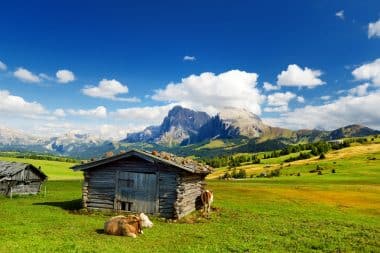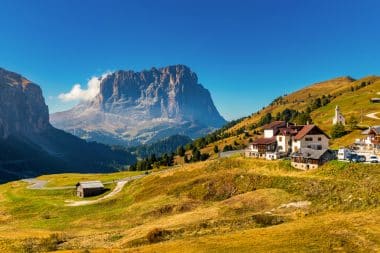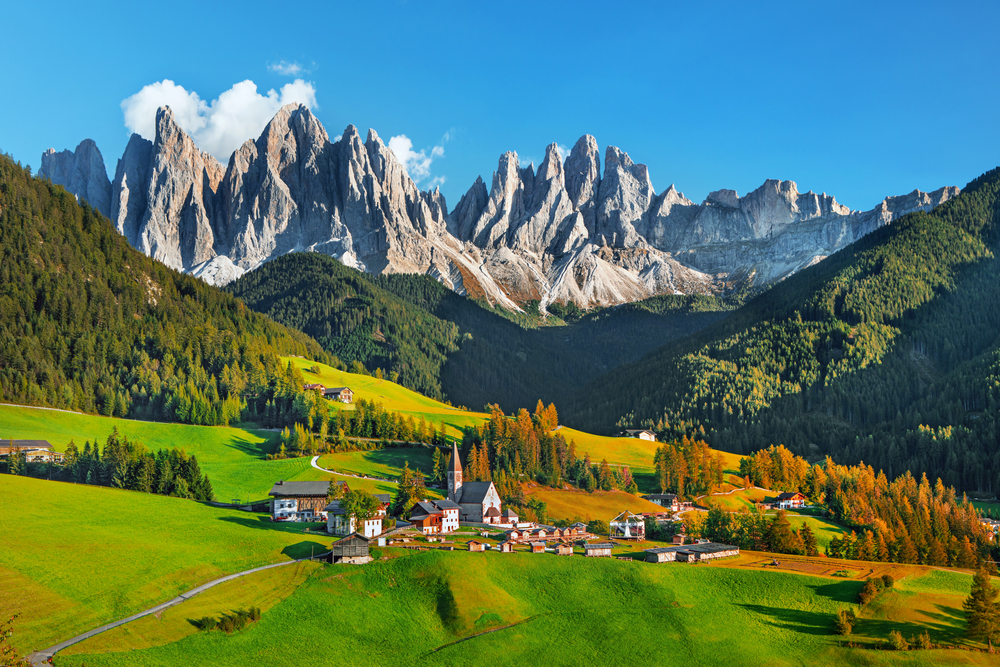The Dolomites, declared a World Heritage Site by UNESCO, are located in the very north of Italy and extend over the regions of South Tyrol/South Tyrol-Trentino, Veneto and Veneto. They are squeezed between the mountains of Austria and the plains of Italy that lead to the Mediterranean Sea. This means contrasting landscapes and climatic conditions – imagine Mediterranean vineyards towering over the imposing mountain peaks.
The area has long been disputed among European powers – in fact, it fell under Austrian rule for centuries before changing hands during World War I and being annexed by Italy; the current autonomous region is home to three official languages, German, Italian and Ladin, the local native language. The capital of the region is the beautiful city of Bolzano, next to the important cities of Trento, Bressanone, Cortina d’Ampezzo and Brunico.
Where to stay in South Tyrol?
South Tyrol is dotted with a wide range of accommodation, including hotels, guesthouses, Airbnbs and alpine huts. Since accommodation in the region can be quite expensive, you should plan at least 100 euros per night.
If you are a fan of AirBnB, there are a wide variety of options in the Dolomites at quite affordable prices. Hotels in the Dolomites range from extravagant 5* luxury (such as the Hotel Miramonti) to traditional, simple alpine inns (Albergo/Gasthof). The quality of hotels and guesthouses in the Dolomites is among the best in the world, and hospitality is a top priority here – so don’t expect run-down, uncomfortable rooms, even at 3*. Rifugio/alpine huts are ubiquitous here in the mountains of the Dolomites and a great place to discover the alpine culture of the region. However, most rifugios in the Dolomites are privately owned and must be booked online well in advance.
Breathtaking hikes in front of a beguiling backdrop
The Dolomites are home to some of the best hiking routes in the world: waking up at dawn to experience the bright sunrises from the mountain peaks, following ancient paths that wind around the rugged Three Peaks, green forests, alpine meadows, past turquoise streams, and of course a hearty rest in picturesque little mountain huts – the Dolomites make every hiker’s heart beat faster. There are many easy day hikes to full and multi-day hikes, where you stop at rifugios high up in the mountains to refuel with alpine food and perhaps a nightcap schnapps. An experience for young and old!
The fascinating Lake Braies
Lake Braies is the most iconic mountain lake in the Dolomites and is world-famous for its emerald waters, ubiquitous boathouse, beautiful spruce forests, and towering limestone spires. Not surprisingly, it’s even more impressive in 3D and worth visiting at sunrise to avoid the crowds and enjoy the beauty of this magical place. If the crowds get too much for you, take the scenic 1-hour walk that runs along the shores of the lake and offers scenic views from almost every angle.
Three Peaks Circular Hiking Trail
The three peaks that have made the Dolomites famous are the Three Peaks: three wildly beautiful rugged monoliths that are as iconic to the area as the Eiffel Tower is to Paris. You will undoubtedly be in awe when they tower above you and you are bathed in their magical light. The 10km loop from Rifugio Auronzo is a great day hike for all skill levels, while history buffs can explore the World War I tunnel systems left behind when these peaks were fiercely contested in World War I.
Hiking on the Alpe di Siusi

The Alpe di Siusi is one of those “too good to be true” places, which is why it has become an Instagram playground in recent years. The largest alpine meadow in Europe offers beautiful views of the rolling hills and alpine huts of the Dolomites. It’s best to hike there at sunrise before the crowds arrive. Please note that it is not allowed to drive to the Alpe di Siusi by car, unless you live in the area or have a permit.
The famous passes of the Dolomites
If you’re planning a road trip through the Dolomites, then you’ll certainly want to tackle some of the region’s incredible mountain passes. There’s nothing quite like slowly winding your way down a stunning mountain road and hairpin bends, surrounded by big trees and ever-taller mountains, with views of the slowly shrinking valleys below you while your favourite music plays.
Passo Gardena

Of all the Dolomite passes, the Val Gardena Pass is by far the most popular. The pass that connects Val Badia to Val Gardena is not only incredibly beautiful (especially at sunrise or sunset), but also a great starting point for a number of incredible hikes and via ferratas, including the wonderful Gran Cir peak. In autumn, the surrounding larches turn a wonderful yellow-orange hue, which makes a trip here even more delicious.
Passo Giau
Nestled between the Croda da Lago and the Cinque Torri, the Passo Giau connects Cortina d’Ampezzo to Selva di Cadore and is perhaps the most beautiful mountain pass in the Dolomites. The 2,236 m high pass winds through dense larch forests and a high alpine plateau, with spectacular views between the surrounding peaks. At the top of the pass, you can take a short walk to the alpine pastures or start a longer hike into the mountains.
Winter sports in the Dolomites
The Dolomites boast one of the largest ski networks in the world. Named after the limestone rock that occurs naturally in these spectacular mountains, the Dolomites offer a unique ski holiday experience that every skier should experience at least once in a lifetime. The Dolomiti Superski offers 12 Bellissima ski areas connected by 450 ski lifts, all combined under one ski pass.
The Dolomiti Superski area offers a true Italian foodie experience, as you combine an impressive high alpine setting, beautiful mountain huts, history and a fun skiing experience with delicious local cuisine washed down with local vino, espresso, bombardino or calimero. The dolce vita (the sweet life) in the Dolomites is something to be proud of!
Können wir Ihnen helfen?
Benötigen Sie Unterstützung bei Ihrer Reiseplanung oder weitergehende Informationen zu einzelnen Reisezielen? Wir freuen uns über Ihre Kontaktaufnahme.


